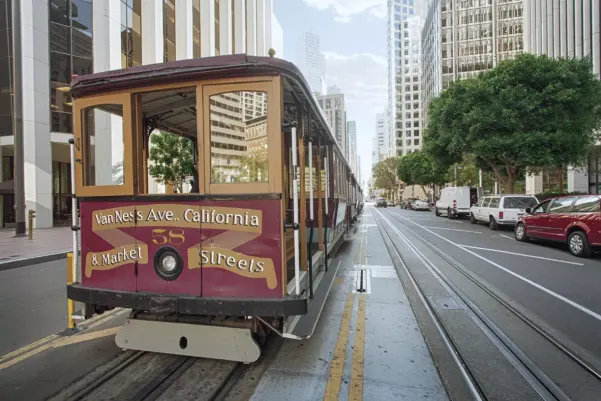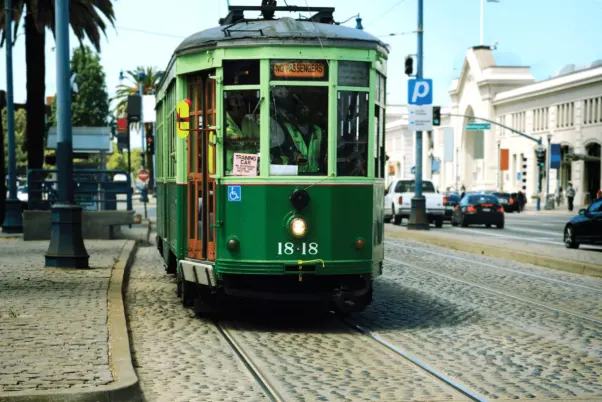Getting Around San Francisco

San Francisco is a densely populated city with an extensive public transportation system, including the world famous Cable Cars, and BART, voted America’s Best Transportation System. Many people are surprised to hear San Francisco only has about 880,000 residents, but there are 7 million from the South Bay to wine country, and from the Pacific Ocean to the inland Delta Region. BART has 121 miles of tracks, that travel from the peninsula through San Francisco out to the East Bay, which makes this a good option for air travelers going from either SFO or OAK to San Francisco. The next option for getting to San Francisco from SFO are the airport shuttles, which are parked one level up from the baggage claim area, and most will take you right to your hotel, but you might not be the first one dropped off. They are like buses that run a route based on the drop off destinations requested.
Whether you’re here for a day or for several weeks, SFMTA makes it simple for visitors to get around the city with ease. A Visitor Passport can be purchased at ticket kiosks, on clipper, via munimobile and sales locations for 1, 3, or 7 consecutive days of unlimited rides on Muni, Muni Metro, historic streetcars, and cable cars. Single ride Cable Car tickets are also available. Purchase your Passports and Cable Car tickets in advance on your smartphone using MuniMobile.
Market Street is the main artery of San Francisco’s transit system, with most bus lines running on Market or crossing it, BART trains three levels down, the MUNI trains out to the neighborhoods two levels down, and the F Line Historic Streetcars running back and forth amongst the pedestrians and buses. Two of the 3 cable car routes end at Hallidie Plaza (named after the Cable Car system’s inventor) where Powell Street begins at Market Street, right across from Nordstrom’s and the rest of the newly expanded Westfield San Francisco Shopping Center. There is a ticket booth where you can purchase passes, and down one level is the Visitor Information Center, and the BART and Muni Train Lobby. At the southwest end of Market is the Castro Neighborhood and the base of Twin Peaks, where the MUNI trains disappear into tunnels that bring them out to the neighborhoods. At the northeast end is the Ferry Building on the Embarcadero that doubles as a unique, historic and tasty food and restaurant mall, and a gateway to the ferry boats to Vallejo, Oakland, Sausalito, and other locations across the water.

A trip to San Francisco would not be complete without a ride on the historic, world-famous cable cars. The first line was completed in 1873, powered by a huge steam engine in the “barn” at Washington and Mason, which has housed an interesting and worthwhile Cable Car Museum since the 70’s. The steam engine drove large wheels, around which were wrapped extremely long steel cables that were painstakingly laid into shallow trenches below the streets through an incredibly complicated maze of pulleys and guides. Each car has a grip that slides down a slot between the rails, and grasps the cable under the direction of the “gripman”, to get pulled forward at the speed of the cable, about 9 miles an hour – thus the term “traction drive railway” applies. The fare per ride is a little steeper than most commuters would like to pay, but passes of various durations combine cable car, the extensive bus lines, and the F line street cars into one comprehensive system that makes getting around convenient for many of the city’s residents and tourists.
But the cable cars are not the only “rolling museums” in the city. Years ago the city invited the world to send its obsolete and idle streetcars to San Francisco, where commuters and tourists use them everyday in large numbers. The “F” Line runs down the middle of Market Street, the main artery of San Francisco’s transportation system. Every new car coming down the line looks different, because one came from Paris, the next one from Louisville, KY, the next one from Boston, then St. Louis, New Orleans, Chicago, Philadelphia, and so on. Some are over 100 years old, and most do not have cushioned seats, but just being able to experience the sights and sounds of Market Street from the Castro District to the Ferry Building, the Embarcadero curving around past the renovated piers, and looping through Fisherman’s Wharf is worth the trip, even if it is a little bumpy.
The MUNI Trains collect people from the southern and western neighborhoods of San Francisco and bring them to Market Street. When the new baseball stadium was built, the lines were extended with a right turn in front of the Ferry building, and curving along the Embarcadero to King Street, past the Ball park and to the CalTrain Station. The CalTrain system brings people north from San Jose through the Peninsula, past SFO, to the end of the line at 4th and King, where they can jump on the MUNI, grab a bus, Uber or a cab.